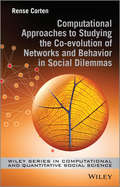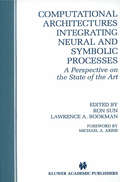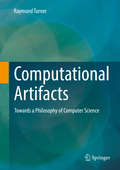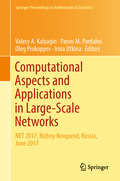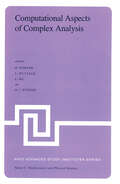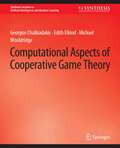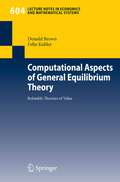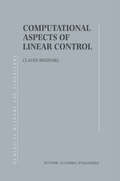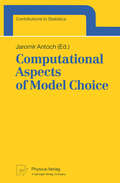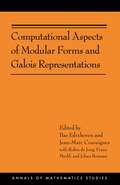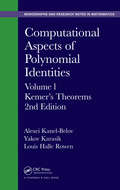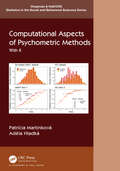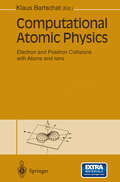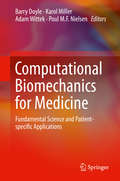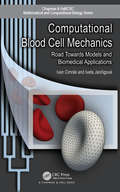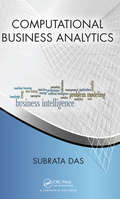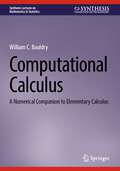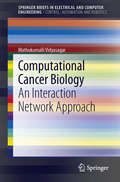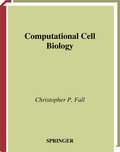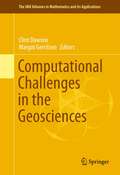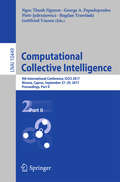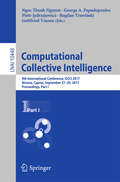- Table View
- List View
Computational Approaches to Studying the Co-evolution of Networks and Behavior in Social Dilemmas: Computational Approaches To Studying The Co-evolution Of Networks And Behaviour In Social Dilemmas (Wiley Series in Computational and Quantitative Social Science)
by Rense CortenComputational Approaches to Studying the Co-evolution of Networks and Behaviour in Social Dilemmas shows students, researchers, and professionals how to use computation methods, rather than mathematical analysis, to answer research questions for an easier, more productive method of testing their models. Illustrations of general methodology are provided and explore how computer simulation is used to bridge the gap between formal theoretical models and empirical applications.
Computational Architectures Integrating Neural and Symbolic Processes: A Perspective on the State of the Art (The Springer International Series in Engineering and Computer Science #292)
by Ron Sun Lawrence A. Bookman Michael A. ArbibComputational Architectures Integrating Neural and Symbolic Processes: A Perspective on the State of the Art focuses on a currently emerging body of research. With the reemergence of neural networks in the 1980s with their emphasis on overcoming some of the limitations of symbolic AI, there is clearly a need to support some form of high-level symbolic processing in connectionist networks. As argued by many researchers, on both the symbolic AI and connectionist sides, many cognitive tasks, e.g. language understanding and common sense reasoning, seem to require high-level symbolic capabilities. How these capabilities are realized in connectionist networks is a difficult question and it constitutes the focus of this book. Computational Architectures Integrating Neural and Symbolic Processes addresses the underlying architectural aspects of the integration of neural and symbolic processes. In order to provide a basis for a deeper understanding of existing divergent approaches and provide insight for further developments in this field, this book presents: (1) an examination of specific architectures (grouped together according to their approaches), their strengths and weaknesses, why they work, and what they predict, and (2) a critique/comparison of these approaches. Computational Architectures Integrating Neural and Symbolic Processes is of interest to researchers, graduate students, and interested laymen, in areas such as cognitive science, artificial intelligence, computer science, cognitive psychology, and neurocomputing, in keeping up-to-date with the newest research trends. It is a comprehensive, in-depth introduction to this new emerging field.
Computational Artifacts: Towards a Philosophy of Computer Science
by Raymond TurnerThe philosophy of computer science is concerned with issues that arise from reflection upon the nature and practice of the discipline of computer science. This book presents an approach to the subject that is centered upon the notion of computational artefact. It provides an analysis of the things of computer science as technical artefacts. Seeing them in this way enables the application of the analytical tools and concepts from the philosophy of technology to the technical artefacts of computer science. With this conceptual framework the author examines some of the central philosophical concerns of computer science including the foundations of semantics, the logical role of specification, the nature of correctness, computational ontology and abstraction, formal methods, computational epistemology and explanation, the methodology of computer science, and the nature of computation. The book will be of value to philosophers and computer scientists.
Computational Aspects and Applications in Large-Scale Networks: NET 2017, Nizhny Novgorod, Russia, June 2017 (Springer Proceedings in Mathematics & Statistics #247)
by Valery A. Kalyagin Panos M. Pardalos Oleg Prokopyev Irina UtkinaContributions in this volume focus on computationally efficient algorithms and rigorous mathematical theories for analyzing large-scale networks. Researchers and students in mathematics, economics, statistics, computer science and engineering will find this collection a valuable resource filled with the latest research in network analysis. Computational aspects and applications of large-scale networks in market models, neural networks, social networks, power transmission grids, maximum clique problem, telecommunication networks, and complexity graphs are included with new tools for efficient network analysis of large-scale networks. This proceeding is a result of the 7th International Conference in Network Analysis, held at the Higher School of Economics, Nizhny Novgorod in June 2017. The conference brought together scientists, engineers, and researchers from academia, industry, and government.
Computational Aspects of Complex Analysis: Proceedings of the NATO Advanced Study Institute held at Braunlage, Harz, Germany, July 26 – August 6, 1982 (Nato Science Series C: #102)
by K. E. Werner L. Wuytack E. NgThe NATO Advanced study Institute (ASI) on "Computational Aspects of Complex Analysis" was held at Braunlage/Harz (Germany) from July 26 to August 6, 1982. These proceedings contain the invited lectures presented at this institute, the aim of which was to bring together scientists from pure and applied mathematics as well as computer scientists. The main topics were problems dealing with approximation and interpolation by polynomial and rational functions (in particular Pade approximation), numerical methods for the solution of algebraic equations and differential equations, the large field of conformal mapping, aspects of computer imple mentation of complex arithmetic and calculations based on complex variable techniques. The sessions on short communications not only provided a platform for the presentation of contributions by the participants of the ASI but also the opportunity to discuss the material more thoroughly, to bring up open problems and to point out the inter relationship of the above mentioned topics. Quite naturally the short communications grouped around the topics of the main lectures. The stimulating atmosphere caused many discussions to continue privately for hours. Even out of the social program there emanated two short communications by L. Wuytack and L. Trefethen, which are included at the end of these proceedings. We gratefully appreciate the support of the International Advisory Committee that was formed by L. Collatz, Germany, C. Brezinski, France, G. Golub, U.S.A., P. Henrici, Switzerland, J. van Hulzen, the Netherlands, O. Skovgaard, Denmark, I. Sneddon, United Kingdom, and J. Todd, U.S.A.
Computational Aspects of Cooperative Game Theory (Synthesis Lectures on Artificial Intelligence and Machine Learning)
by Georgios Raedt Edith KerstingCooperative game theory is a branch of (micro-)economics that studies the behavior of self-interested agents in strategic settings where binding agreements among agents are possible. Our aim in this book is to present a survey of work on the computational aspects of cooperative game theory. We begin by formally defining transferable utility games in characteristic function form, and introducing key solution concepts such as the core and the Shapley value. We then discuss two major issues that arise when considering such games from a computational perspective: identifying compact representations for games, and the closely related problem of efficiently computing solution concepts for games. We survey several formalisms for cooperative games that have been proposed in the literature, including, for example, cooperative games defined on networks, as well as general compact representation schemes such as MC-nets and skill games. As a detailed case study, we consider weighted voting games: a widely-used and practically important class of cooperative games that inherently have a natural compact representation. We investigate the complexity of solution concepts for such games, and generalizations of them. We briefly discuss games with non-transferable utility and partition function games. We then overview algorithms for identifying welfare-maximizing coalition structures and methods used by rational agents to form coalitions (even under uncertainty), including bargaining algorithms. We conclude by considering some developing topics, applications, and future research directions.
Computational Aspects of General Equilibrium Theory: Refutable Theories of Value (Lecture Notes in Economics and Mathematical Systems #604)
by Donald Brown Felix KublerThis monograph presents a general equilibrium methodology for microeconomic policy analysis. It is intended to serve as an alternative to the now classical, axiomatic general equilibrium theory as exposited in Debreu`s Theory of Value (1959) or Arrow and Hahn`s General Competitive Analysis (1971). The monograph consists of several essays written over the last decade. It also contains an appendix by Charles Steinhorn on the elements of O-minimal structures.
Computational Aspects of Linear Control (Numerical Methods and Algorithms #1)
by Claude BrezinskiMany devices (we say dynamical systems or simply systems) behave like black boxes: they receive an input, this input is transformed following some laws (usually a differential equation) and an output is observed. The problem is to regulate the input in order to control the output, that is for obtaining a desired output. Such a mechanism, where the input is modified according to the output measured, is called feedback. The study and design of such automatic processes is called control theory. As we will see, the term system embraces any device and control theory has a wide variety of applications in the real world. Control theory is an interdisci plinary domain at the junction of differential and difference equations, system theory and statistics. Moreover, the solution of a control problem involves many topics of numerical analysis and leads to many interesting computational problems: linear algebra (QR, SVD, projections, Schur complement, structured matrices, localization of eigenvalues, computation of the rank, Jordan normal form, Sylvester and other equations, systems of linear equations, regulariza tion, etc), root localization for polynomials, inversion of the Laplace transform, computation of the matrix exponential, approximation theory (orthogonal poly nomials, Pad6 approximation, continued fractions and linear fractional transfor mations), optimization, least squares, dynamic programming, etc. So, control theory is also a. good excuse for presenting various (sometimes unrelated) issues of numerical analysis and the procedures for their solution. This book is not a book on control.
Computational Aspects of Model Choice (Contributions to Statistics)
by Jaromir AntochAlthough no-one is, probably, too enthused about the idea, it is a fact that the development of most empirical sciences to a great extend depends of the development of data analysis methods and techniques, which, due to the necessity of applications of computers for that pur pose, actually means that it practically depends on the advancements and orientation of computational statistics. This volume contains complete texts of the lectures held during the Summer School on "Computational Aspects of Model Choice" orga nized jointly by Charles University, Prague, and International Associa tion for Statistical Computing (IASC) on July 1-14, 1991, in Prague. Main aims of the Summer School were to review and analyse some of the recent developments concerning computational aspects of the model choice as well as their theoretical background. The topics covers the problems of the change point detection, robust estimation and its computational aspects, classification using binary trees, stochastic ap proximation and optimization including the discussion about available software, computational aspects of graphical model selection and mul tiple hypotheses testing. The bridge between these different approaches is formed by the survey paper about statistical applications of artificial intelligence.
Computational Aspects of Modular Forms and Galois Representations: How One Can Compute in Polynomial Time the Value of Ramanujan's Tau at a Prime (AM-176)
by Bas Edixhoven Jean-Marc Couveignes Robin De Jong Franz Merkl Johan BosmanModular forms are tremendously important in various areas of mathematics, from number theory and algebraic geometry to combinatorics and lattices. Their Fourier coefficients, with Ramanujan's tau-function as a typical example, have deep arithmetic significance. Prior to this book, the fastest known algorithms for computing these Fourier coefficients took exponential time, except in some special cases. The case of elliptic curves (Schoof's algorithm) was at the birth of elliptic curve cryptography around 1985. This book gives an algorithm for computing coefficients of modular forms of level one in polynomial time. For example, Ramanujan's tau of a prime number p can be computed in time bounded by a fixed power of the logarithm of p. Such fast computation of Fourier coefficients is itself based on the main result of the book: the computation, in polynomial time, of Galois representations over finite fields attached to modular forms by the Langlands program. Because these Galois representations typically have a nonsolvable image, this result is a major step forward from explicit class field theory, and it could be described as the start of the explicit Langlands program. The computation of the Galois representations uses their realization, following Shimura and Deligne, in the torsion subgroup of Jacobian varieties of modular curves. The main challenge is then to perform the necessary computations in time polynomial in the dimension of these highly nonlinear algebraic varieties. Exact computations involving systems of polynomial equations in many variables take exponential time. This is avoided by numerical approximations with a precision that suffices to derive exact results from them. Bounds for the required precision--in other words, bounds for the height of the rational numbers that describe the Galois representation to be computed--are obtained from Arakelov theory. Two types of approximations are treated: one using complex uniformization and another one using geometry over finite fields. The book begins with a concise and concrete introduction that makes its accessible to readers without an extensive background in arithmetic geometry. And the book includes a chapter that describes actual computations.
Computational Aspects of Modular Forms and Galois Representations: How One Can Compute in Polynomial Time the Value of Ramanujan's Tau at a Prime (AM-176) (PDF)
by Bas Edixhoven Jean-Marc Couveignes Robin De Jong Franz Merkl Johan BosmanModular forms are tremendously important in various areas of mathematics, from number theory and algebraic geometry to combinatorics and lattices. Their Fourier coefficients, with Ramanujan's tau-function as a typical example, have deep arithmetic significance. Prior to this book, the fastest known algorithms for computing these Fourier coefficients took exponential time, except in some special cases. The case of elliptic curves (Schoof's algorithm) was at the birth of elliptic curve cryptography around 1985. This book gives an algorithm for computing coefficients of modular forms of level one in polynomial time. For example, Ramanujan's tau of a prime number p can be computed in time bounded by a fixed power of the logarithm of p. Such fast computation of Fourier coefficients is itself based on the main result of the book: the computation, in polynomial time, of Galois representations over finite fields attached to modular forms by the Langlands program. Because these Galois representations typically have a nonsolvable image, this result is a major step forward from explicit class field theory, and it could be described as the start of the explicit Langlands program. The computation of the Galois representations uses their realization, following Shimura and Deligne, in the torsion subgroup of Jacobian varieties of modular curves. The main challenge is then to perform the necessary computations in time polynomial in the dimension of these highly nonlinear algebraic varieties. Exact computations involving systems of polynomial equations in many variables take exponential time. This is avoided by numerical approximations with a precision that suffices to derive exact results from them. Bounds for the required precision--in other words, bounds for the height of the rational numbers that describe the Galois representation to be computed--are obtained from Arakelov theory. Two types of approximations are treated: one using complex uniformization and another one using geometry over finite fields. The book begins with a concise and concrete introduction that makes its accessible to readers without an extensive background in arithmetic geometry. And the book includes a chapter that describes actual computations.
Computational Aspects of Polynomial Identities: Volume l, Kemer's Theorems, 2nd Edition
by Alexei Kanel-Belov Yakov Karasik Louis Halle RowenComputational Aspects of Polynomial Identities: Volume l, Kemer's Theorems, 2nd Edition presents the underlying ideas in recent polynomial identity (PI)-theory and demonstrates the validity of the proofs of PI-theorems. This edition gives all the details involved in Kemer's proof of Specht's conjecture for affine PI-algebras in characteristic 0.The
Computational Aspects of Psychometric Methods: With R (Chapman & Hall/CRC Statistics in the Social and Behavioral Sciences)
by Patricia Martinková Adéla HladkáThis book covers the computational aspects of psychometric methods involved in developing measurement instruments and analyzing measurement data in social sciences. It covers the main topics of psychometrics such as validity, reliability, item analysis, item response theory models, and computerized adaptive testing. The computational aspects comprise the statistical theory and models, comparison of estimation methods and algorithms, as well as an implementation with practical data examples in R and also in an interactive ShinyItemAnalysis application. Key Features: Statistical models and estimation methods involved in psychometric research Includes reproducible R code and examples with real datasets Interactive implementation in ShinyItemAnalysis application The book is targeted toward a wide range of researchers in the field of educational, psychological, and health-related measurements. It is also intended for those developing measurement instruments and for those collecting and analyzing data from behavioral measurements, who are searching for a deeper understanding of underlying models and further development of their analytical skills.
Computational Aspects of Psychometric Methods: With R (Chapman & Hall/CRC Statistics in the Social and Behavioral Sciences)
by Patricia Martinková Adéla HladkáThis book covers the computational aspects of psychometric methods involved in developing measurement instruments and analyzing measurement data in social sciences. It covers the main topics of psychometrics such as validity, reliability, item analysis, item response theory models, and computerized adaptive testing. The computational aspects comprise the statistical theory and models, comparison of estimation methods and algorithms, as well as an implementation with practical data examples in R and also in an interactive ShinyItemAnalysis application. Key Features: Statistical models and estimation methods involved in psychometric research Includes reproducible R code and examples with real datasets Interactive implementation in ShinyItemAnalysis application The book is targeted toward a wide range of researchers in the field of educational, psychological, and health-related measurements. It is also intended for those developing measurement instruments and for those collecting and analyzing data from behavioral measurements, who are searching for a deeper understanding of underlying models and further development of their analytical skills.
Computational Atomic Physics: Electron and Positron Collisions with Atoms and Ions
by K. Bartschat I. E. McCarthy R. P. McEachran D. H Madison Z. XixiangComputational Atomic Physics deals with computational methods for calculating electron (and positron) scattering from atoms and ions, including elastic scattering, excitation, and ionization processes. Each chapter is divided into abstract, theory, computer program with sample input and output, summary, suggested problems, and references. An MS-DOS diskette is included, which holds 11 programs covering the features of each chapter and therefore contributing to a deeper understanding of the field. Thus the book provides a unique practical application of advanced quantum mechanics.
Computational Biomechanics for Medicine: Fundamental Science and Patient-specific Applications
by Barry Doyle Karol Miller Adam Wittek Poul M. F. NielsenOne of the greatest challenges facing the computational engineering community is to extend the success of computational mechanics to fields outside traditional engineering, in particular to biology, the biomedical sciences and medicine. The Computational Biomechanics for Medicine series provides an opportunity for specialists in computational biomechanics to present their latest methodologies and advancements. This 5th edition comprises nine of the latest developments in both fundamental science and patient-specific applications, from researchers in Australia, New Zealand, USA, UK, France, Ireland and China. Some of the interesting topics discussed are: cellular mechanics; tumor growth and modeling; medical image analysis and both patient-specific fluid dynamics and solid mechanic simulations.
Computational Blood Cell Mechanics: Road Towards Models and Biomedical Applications (Chapman & Hall/CRC Computational Biology Series)
by Ivan Cimrak Iveta JancigovaSimulating blood cells for biomedical applications is a challenging goal. Whether you want to investigate blood flow behavior on the cell scale, or use a blood cell model for fast computational prototyping in microfluidics, Computational Blood Cell Mechanics will help you get started, and show you the path forward. The text presents a step-by-step approach to cell model building that can be adopted when developing and validating models for biomedical applications, such as filtering and sorting cells, or examining flow and deformations of individual cells under various conditions. It starts with basic building-blocks that, together, model the red blood cell membrane according to its physical properties, before moving on to discuss several issues that may pose problems along the way, and finally leads to suggestions on how to set up computational experiments. More details available at www.compbloodcell.eu
Computational Blood Cell Mechanics: Road Towards Models and Biomedical Applications (Chapman & Hall/CRC Computational Biology Series)
by Ivan Cimrak Iveta JancigovaSimulating blood cells for biomedical applications is a challenging goal. Whether you want to investigate blood flow behavior on the cell scale, or use a blood cell model for fast computational prototyping in microfluidics, Computational Blood Cell Mechanics will help you get started, and show you the path forward. The text presents a step-by-step approach to cell model building that can be adopted when developing and validating models for biomedical applications, such as filtering and sorting cells, or examining flow and deformations of individual cells under various conditions. It starts with basic building-blocks that, together, model the red blood cell membrane according to its physical properties, before moving on to discuss several issues that may pose problems along the way, and finally leads to suggestions on how to set up computational experiments. More details available at www.compbloodcell.eu
Computational Business Analytics: Computational Business Analytics
by Subrata DasLearn How to Properly Use the Latest Analytics Approaches in Your OrganizationComputational Business Analytics presents tools and techniques for descriptive, predictive, and prescriptive analytics applicable across multiple domains. Through many examples and challenging case studies from a variety of fields, practitioners easily see the connections
Computational Calculus: A Numerical Companion to Elementary Calculus (Synthesis Lectures on Mathematics & Statistics)
by William C. BauldryThis book offers readers the methods that are necessary to apply the power of calculus to analyze real problems. While most calculus textbooks focus on formula-based calculus, this book explains how to do the analysis of calculus, rates of change, and accumulation from data. The author’s introductory approach prepares students with the techniques to handle numerically-based problems in more advanced classes or in real-world applications. This self-contained book uses the computer algebra system Maple for computation, and the material is easily adaptable for calculators or other computer algebra systems. The author includes historical context and example exercises throughout the book in order to provide readers with a thorough understanding of the topic. This book:Prepares students with the techniques to handle numerically-based problems in in real-world applicationsProvides historical context and example exercises to give a thorough understanding of the topicUtilizes Maple for computation and is adaptable for calculators or other computer algebra systems
Computational Cancer Biology: An Interaction Network Approach (SpringerBriefs in Electrical and Computer Engineering)
by Mathukumalli VidyasagarThis brief introduces people with a basic background in probability theory to various problems in cancer biology that are amenable to analysis using methods of probability theory and statistics. The title mentions “cancer biology” and the specific illustrative applications reference cancer data but the methods themselves are more broadly applicable to all aspects of computational biology. Aside from providing a self-contained introduction to basic biology and to cancer, the brief describes four specific problems in cancer biology that are amenable to the application of probability-based methods. The application of these methods is illustrated by applying each of them to actual data from the biology literature. After reading the brief, engineers and mathematicians should be able to collaborate fruitfully with their biologist colleagues on a wide variety of problems.
Computational Cell Biology (Interdisciplinary Applied Mathematics #20)
by Christopher P. Fall Eric S. Marland John M. Wagner John J. TysonThis textbook provides an introduction to dynamic modeling in molecular cell biology, taking a computational and intuitive approach. Detailed illustrations, examples, and exercises are included throughout the text. Appendices containing mathematical and computational techniques are provided as a reference tool.
Computational Challenges in the Geosciences (The IMA Volumes in Mathematics and its Applications #156)
by Clint Dawson and Margot GerritsenComputational Challenges in the Geosciences addresses a cross-section of grand challenge problems arising in geoscience applications, including groundwater and petroleum reservoir simulation, hurricane storm surge, oceanography, volcanic eruptions and landslides, and tsunamis. Each of these applications gives rise to complex physical and mathematical models spanning multiple space-time scales, which can only be studied through computer simulation. The data required by the models is often highly uncertain, and the numerical solution of the models requires sophisticated algorithms which are mathematically accurate, computationally efficient and yet must preserve basic physical properties of the models. This volume summarizes current methodologies and future research challenges in this broad and important field.
Computational Collective Intelligence: 9th International Conference, ICCCI 2017, Nicosia, Cyprus, September 27-29, 2017, Proceedings, Part II (Lecture Notes in Computer Science #10449)
by Ngoc Thanh Nguyen George A. Papadopoulos Piotr Jędrzejowicz Bogdan Trawiński Gottfried VossenThis two-volume set (LNAI 10448 and LNAI 10449) constitutes the refereed proceedings of the 9th International Conference on Collective Intelligence, ICCCI 2017, held in Nicosia, Cyprus, in September 2017. The 117 full papers presented were carefully reviewed and selected from 248 submissions. The conference focuseson the methodology and applications of computational collective intelligence, included: multi-agent systems, knowledge engineering and semantic web, social networks and recommender systems, text processing and information retrieval, data mining methods and applications, sensor networks and internet of things, decision support & control systems, and computer vision techniques.
Computational Collective Intelligence: 9th International Conference, ICCCI 2017, Nicosia, Cyprus, September 27-29, 2017, Proceedings, Part I (Lecture Notes in Computer Science #10448)
by Ngoc Thanh Nguyen George A. Papadopoulos Piotr Jędrzejowicz Bogdan Trawiński Gottfried VossenThis two-volume set (LNAI 10448 and LNAI 10449) constitutes the refereed proceedings of the 9th International Conference on Collective Intelligence, ICCCI 2017, held in Nicosia, Cyprus, in September 2017. The 117 full papers presented were carefully reviewed and selected from 248 submissions. The conference focuseson the methodology and applications of computational collective intelligence, included: multi-agent systems, knowledge engineering and semantic web, social networks and recommender systems, text processing and information retrieval, data mining methods and applications, sensor networks and internet of things, decision support & control systems, and computer vision techniques.
